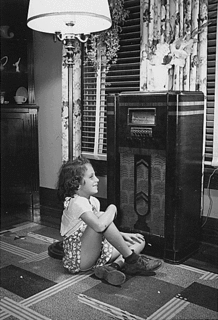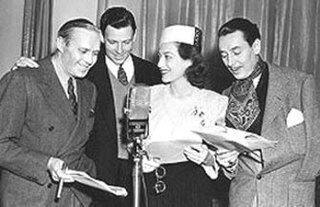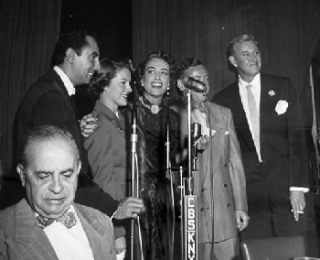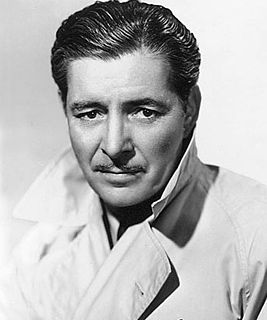
The Golden Age of Radio, also known as the old-time radio (OTR) era, was an era of radio in the United States where it was the dominant electronic home entertainment medium. It began with the birth of commercial radio broadcasting in the early 1920s and lasted through the 1950s, when television gradually superseded radio as the medium of choice for scripted programming, variety and dramatic shows.

The Campbell Playhouse (1938–1940) is a live CBS radio drama series directed by and starring Orson Welles. Produced by Welles and John Houseman, it was a sponsored continuation of The Mercury Theatre on the Air. The series offered hour-long adaptations of classic plays and novels, as well as adaptations of popular motion pictures.

Lux Radio Theatre, sometimes spelled Lux Radio Theater, a classic radio anthology series, was broadcast on the NBC Blue Network (1934–35) ; CBS Radio network (1935–54), and NBC Radio (1954–55). Initially, the series adapted Broadway plays during its first two seasons before it began adapting films. These hour-long radio programs were performed live before studio audiences. The series became the most popular dramatic anthology series on radio, broadcast for more than 20 years and continued on television as the Lux Video Theatre through most of the 1950s. The primary sponsor of the show was Unilever through its Lux Soap brand.

The United States Steel Hour is an anthology series which brought hour long dramas to television from 1953 to 1963. The television series and the radio program that preceded it were both sponsored by the United States Steel Corporation.

Graham McNamee was an American radio broadcaster, the medium's most recognized national personality in its first international decade. He originated play-by-play sports broadcasting for which he was awarded the Ford C. Frick Award by the Baseball Hall of Fame in 2016.

An anthology series is a radio, television, or film series that spans through different genres, and presents a different story and a different set of characters in each episode, season, segment or short. These usually have a different cast in each episode, but several series in the past, such as Four Star Playhouse, employed a permanent troupe of character actors who would appear in a different drama each week. Some anthology series, such as Studio One, began on radio and then expanded to television.
Ford Theatre, spelled Ford Theater for the radio version and known as The Ford Television Theatre for the TV version, is a radio and television anthology series broadcast in the United States in the 1940s and 1950s. At various times the television series appeared on all three major television networks, while the radio version was broadcast on two separate networks and on two separate coasts. Ford Theatre was named for its sponsor, the Ford Motor Company, which had an earlier success with its concert music series, The Ford Sunday Evening Hour (1934–42).
The year 1932 saw a number of significant happenings in radio broadcasting history.
The year 1930 saw a number of significant happenings in radio broadcasting history.

The Screen Guild Theater is a radio anthology series broadcast from 1939 until 1952 during the Golden Age of Radio. Leading Hollywood stars performed adaptations of popular motion pictures. Originating on CBS Radio, it aired under several different titles including The Gulf Screen Guild Show, The Gulf Screen Guild Theater, The Lady Esther Screen Guild Theater and The Camel Screen Guild Players. Fees that would ordinarily have been paid to the stars and studios were instead donated to the Motion Picture Relief Fund, and were used for the construction and maintenance of the Motion Picture Country House.
Author's Playhouse is an anthology radio drama series created by Wynn Wright, that aired on Mutual in 1940–1941, and on the NBC Blue Network from March 5, 1941, until October 1941. It then moved to the NBC Red Network where it was heard until June 4, 1945. Philip Morris was the sponsor between 1942 and 1943.

Screen Directors Playhouse is an American radio and television anthology series which brought leading Hollywood actors to the NBC microphones beginning in 1949. The radio program broadcast adaptations of films, with original directors of the films sometimes involved in the productions, although their participation was usually limited to introducing the radio adaptations and taking a brief "curtain call" with the cast and host at the end of the program. During the 1955–56 season, the series was seen on television, focusing on original teleplays and several adaptations of famous short stories.
Hollywood Playhouse, also known as Woodbury Hollywood Playhouse, is a radio anthology drama series that featured adaptations of plays and short stories. Created as a showcase for Tyrone Power, the series began October 3, 1937, on the Blue Network, with Darryl F. Zanuck introducing his 20th Century-Fox star. The half-hour program aired Sundays at 9 p.m. ET until September 1939, when it was moved to the NBC Red Network Wednesdays at 8 pm ET. Woodbury Soap and Jergens Lotion sponsored the show.
Hollywood Star Playhouse is a radio dramatic anthology series in the United States. It was broadcast April 24, 1950-February 15, 1953, appearing on CBS, ABC and NBC over that span.
Stars over Hollywood is a radio anthology in the United States. It was broadcast on CBS from May 31, 1941, to September 25, 1954, sponsored first by Dari-Rich, Carnation Milk and later by Armour and Company.
The MGM Theater of the Air is a one-hour radio dramatic anthology in the United States. It was broadcast on WMGM in New York City and syndicated to other stations via electrical transcription October 14, 1949 – December 7, 1951. It was carried on Mutual January 5-December 27, 1952.
ABC Mystery Theater, also known as just simply Mystery Theater or Mystery Theatre, was an American radio anthology, crime and mystery series from the 1950s. The program starred originally, actor Robert Carroll in the title role of Inspector Mark Saber, a British detective from the Homicide Squad then by actor Les Damon for seasons two and three. The program also centered on Saber's assistant Sgt. Tim Maloney, originally portrayed by character actor James Westerfield for the first half of season one, actor Douglas Chandler for the second half of season one and finally by character actor Walter Burke for seasons two and three.
For the record album of the same name, see Curtain Time.

Favorite Story is an American old-time radio dramatic anthology. It was nationally syndicated by the Ziv Company from 1946 to 1949. The program was "advertised as a show that 'stands head and shoulders above the finest programs on the air'". Originating at KFI in Los Angeles, California, Favorite Story apparently was not related to the similarly named My Favorite Story that ran on KNX in Los Angeles earlier.








